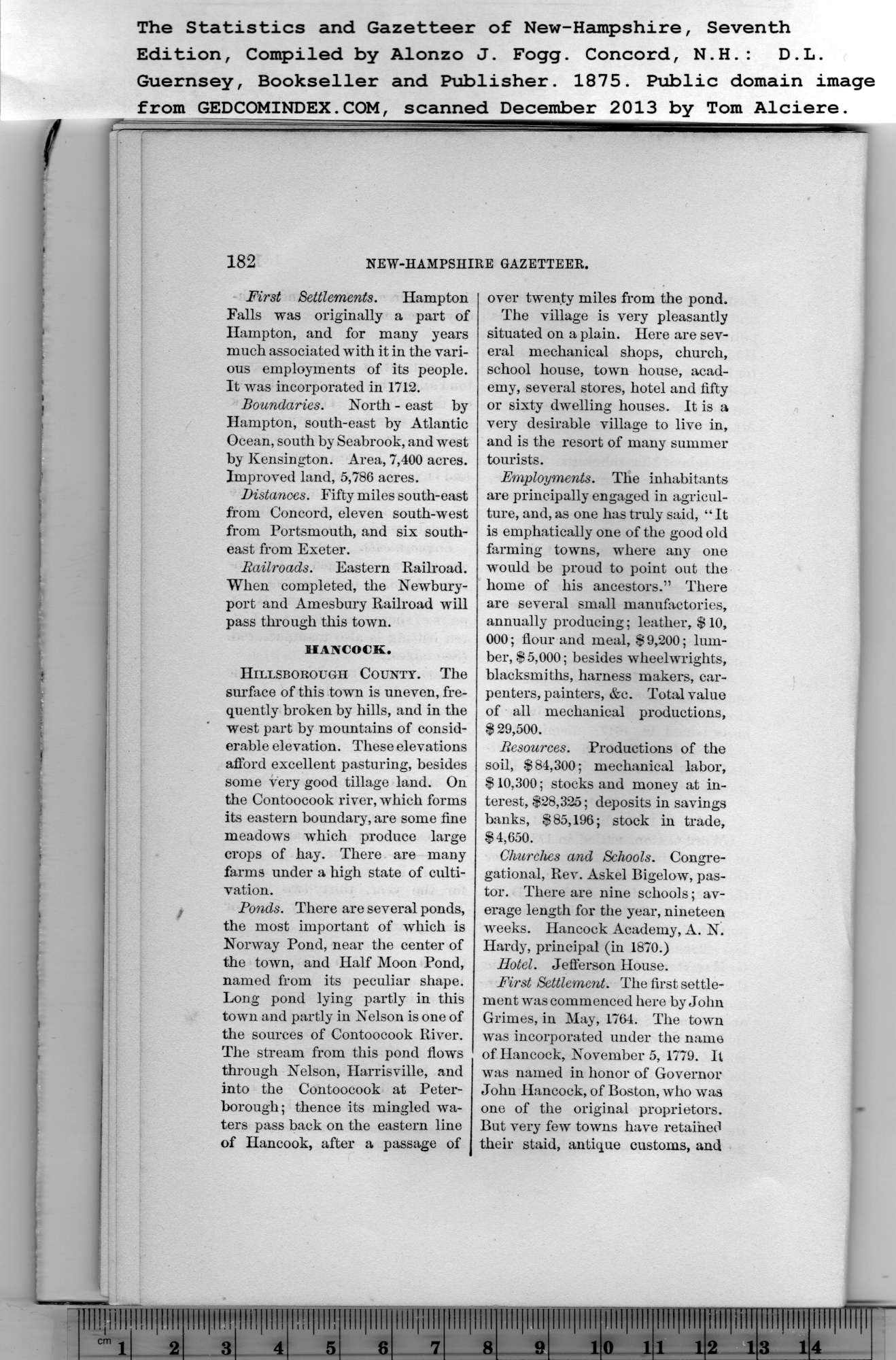|
182
The Statistics and Gazetteer of New-Hampshire, Seventh
Edition, Compiled by Alonzo J. Fogg. Concord, N.H.: D.L.
First Settlements. Hampton
Falls was originally a part of
Hampton, and for many years
much associated with it in the vari-
ous employments of its people.
It was incorporated in 1712.
Boundaries. North - east by
Hampton, south-east by Atlantic
Ocean, south by Seabrook, and west
by Kensington. Area, 7,400 acres.
Improved land, 5,786 acres.
Distances. Fifty miles south-east
from Concord, eleven south-west
from Portsmouth, and six south-
east from Exeter.
Railroads. Eastern Railroad.
When completed, the Newbury-
port and Amesbury Railroad will
pass through this town.
HANCOCK.
Hillsborough County. The
surface of this town is uneven, fre-
quently broken by hills, and in the
west part by mountains of consid-
erable elevation. These elevations
afford excellent pasturing, besides
some very good tillage land. On
the Contoocook river, which forms
its eastern boundary, are some fine
meadows which produce large
crops of hay. There are many
farms under a high state of culti-
vation.
Ponds. There are several ponds,
the most important of which is
Norway Pond, near the center of
the town, and Half Moon Pond,
named from its peculiar shape.
Long pond lying partly in this
town and partly in Nelson is one of
the sources of Contoocook River.
The stream from this pond flows
through Nelson, Harrisville, and
into the Contoocook at Peter-
borough; thence its mingled wa-
ters pass back on the eastern line
of Hancook, after a passage of |
over twenty miles from the pond.
The village is very pleasantly
situated on a plain. Here are sev-
eral mechanical shops, church,
school house, town house, acad-
emy, several stores, hotel and fifty
or sixty dwelling houses. It is a
very desirable village to live in,
and is the resort of many summer
tourists.
Employments. The inhabitants
are principally engaged in agricul-
ture, and, as one has truly said, “It
is emphatically one of the good old
farming towns, where any one
would be proud to point out the
home of his ancestors.” There
are several small manufactories,
annually producing; leather, $ 10,
000; flour and meal, $ 9,200; lum-
ber, $5,000; besides wheelwrights,
blacksmiths, harness makers, car-
penters, painters, &c. Total value
of all mechanical productions,
$ 29,500.
Resources. Productions of the
soil, $84,300; mechanical labor,
$ 10,300; stocks and money at in-
terest, $28,325; deposits in savings
banks, $85,196; stock in trade,
$4,650.
Churches and Schools. Congre-
gational, Rev. Askel Bigelow, pas-
tor. There are nine schools; av-
erage length for the year, nineteen
weeks. Hancock Academy, A. N.
Hardy, principal (in 1870.)
Hotel. Jefferson House.
First Settlement. The first settle-
ment was commenced here by John
Grimes, in May, 1764. The town
was incorporated under the name
of Hancock, November 5, 1779. It
was named in honor of Governor
John Hancock, of Boston, who was
one of the original proprietors.
But very few towns have retained
their staid, antique customs, and |
